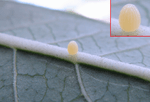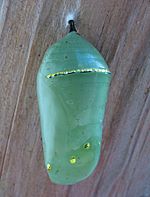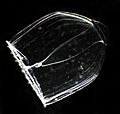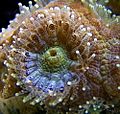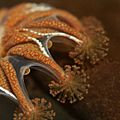Life cycle facts for kids
A life cycle describes all the stages a living thing goes through from birth to death. It shows how an organism grows, changes, and reproduces.
For some living things, like humans, the changes are slow. We grow from a child into an adult over many years. This change happens little by little.
For many insects, the changes are very clear and happen in distinct steps. They go from an egg to a larva, then a pupa, and finally an imago (adult). Each stage looks very different from the last.
Contents
Amazing Animal Life Cycles
Sometimes, the parent generation of an animal looks very different from its offspring. This means the animal changes its form during its life cycle. Often, one form will reproduce sexually, while another form might not, or might reproduce asexually.
Parasites and Their Hosts
Parasites are organisms that live on or inside another organism, called a host. They get food and shelter from the host, but they harm it. Many parasites have very complex life cycles. They often need different hosts for different stages of their development.
For example, some parasites that live in plant-eating mammals might start as an egg. This egg then develops inside a snail host. After that, it moves to a mammal host to complete its life cycle.
Malaria is a disease caused by tiny, single-celled parasites. These parasites have two main stages in their life cycle. One stage happens inside the blood of mosquitoes. The other stage happens inside the blood of humans.
Cnidaria: Jellyfish and Polyps
Examples of animals with different forms in their life cycle can also be found in the Cnidaria group. These animals live in the ocean or in freshwater. Their bodies are usually quite simple. Some Cnidaria live alone, while others form colonies. In a colony, many individual animals live together. Each animal in a colony often has a special job and needs the others to survive.
The Jellyfish Life Cycle
A great example of different forms is the jellyfish. It has two main forms:
- The medusa form: This is what most people think of as a jellyfish. It can reproduce sexually. Medusas often float freely in the water.
- The polyp form: This form does not reproduce sexually. Polyps are usually attached to the sea floor or another hard surface. Coral reefs are actually large colonies of polyps.
In a complete jellyfish life cycle, the offspring of a medusa will grow into a polyp. Then, the offspring of a polyp will develop into a medusa. This cycle repeats itself.
Variations in Cnidaria Life Cycles
Sometimes, the life cycle of Cnidaria is changed or incomplete. The Anthozoa group includes sea anemones and corals. In these animals, there is only a polyp stage. They do not have a medusa stage at all.
The box jellyfish is another small group of Cnidaria. In their life cycle, the polyp actually changes directly into the medusa. Sometimes, only part of the polyp transforms. The part that is left can then grow back to form a new polyp. Box jellyfish are also known for their very strong poison, which can be dangerous to humans.
In the stalked jellyfish, there is only one form. This form looks like a medusa, but it stays attached to a surface.
-
The sea wasp, a type of box jellyfish
Related pages
See also
 In Spanish: Ciclo de vida para niños
In Spanish: Ciclo de vida para niños


